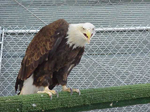|
A
WILL TO LIVE: A BALD EAGLES STORY
by Sharon Walters
Every year we receive a patient or two that challenges the will
to survive, defies all odds or displays what we as mankind call
a miracle.
This story is about an eagle named "Opey" . When he
arrived, he exhibited the tell tale signs of organophosphate
poisoning. After watching many eagles, hawks and other wildlife
succumb to man's pesticides, a chill of horror that it may happen
again struck everyone in the center.
When rescued, this adult male bald eagle was helpless. He laid
face down on his chest with left outstretched behind him, and
talons clenched. He was unable to move any part of his body
except his head. Terrified by his human captors, the poison
moves rapidly. As organophosphate poison continues to do its
damage, victims are unable to even blink. Near the end respiration
also becomes paralyzed and death follows rapidly, due to man's
ignorance.
"Opey" was no exception, and respiration began to
fail as soon as he arrived back at the clinic. Antidotes for
the poison were given, but too much of the poison was present,
and due to a full crop of poisoned food, more was being digested
at a rapid rate. After phone calls to several area veterinarians,
emergency crop surgery was performed and the poisoned food removed.
He was left under gas anesthesia for longer than normal to enable
breathing to come easier. As the hours passed, antidotes were
continued, with much supportive care. He eventually recovered
from surgery, and initially began to show improvement.
Complications set in and the bird began regurgitating fluid
that could not be reached in surgery. Some of this fluid was
inhaled into the lungs, and the bird developed Ecoli in the
lungs, as well as bacterial pneumonia, both of which did not
respond to normal drugs. Extensive lab work was done to find
an antibiotic that would work. It was found that one of them
was a very expensive human drug. During the lab work it was
also discovered that "Opey" had aspergillus, a deadly
fungal disease to both man and beast. Although he had been on
medication to prevent it from happening (at $200.00 a bottle)
he still fell prey to this deadly disease. Immediate medication
changes were done and he is presently on a more expensive anti-fungal
drug. In addition, he just completed a round of antibiotics
that were equally as expensive.
This spiritually strong bird has so far defied all odds, and
keeps fighting for life. Due to the effects of the poison he
has developed nerve and muscle weakness in his feet but continues
to improve daily in this area. He will continue to be on anti-fungal
drugs for three months, and there is no guarantee he will survive.
To date he has made marked improvements but has a long road
to recovery. The amazing part of the study is that the levels
of poison in his system were higher than any bird dead or alive.
Moreover, the levels were so high the bird should have been
dead before he was ever admitted.
|

|
|